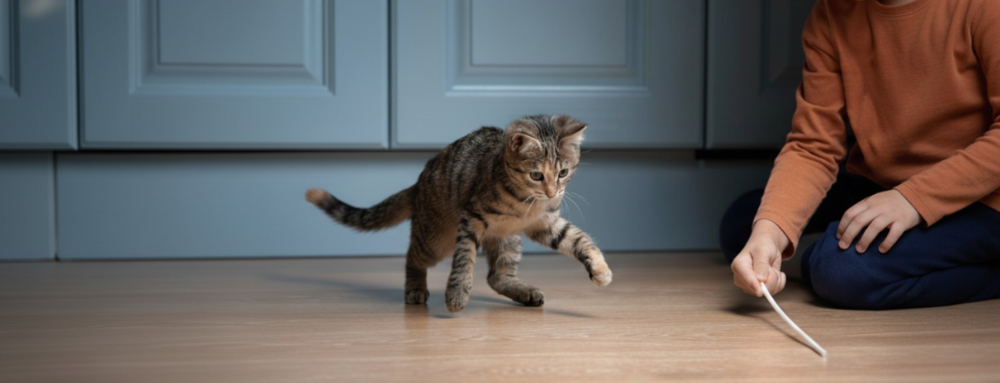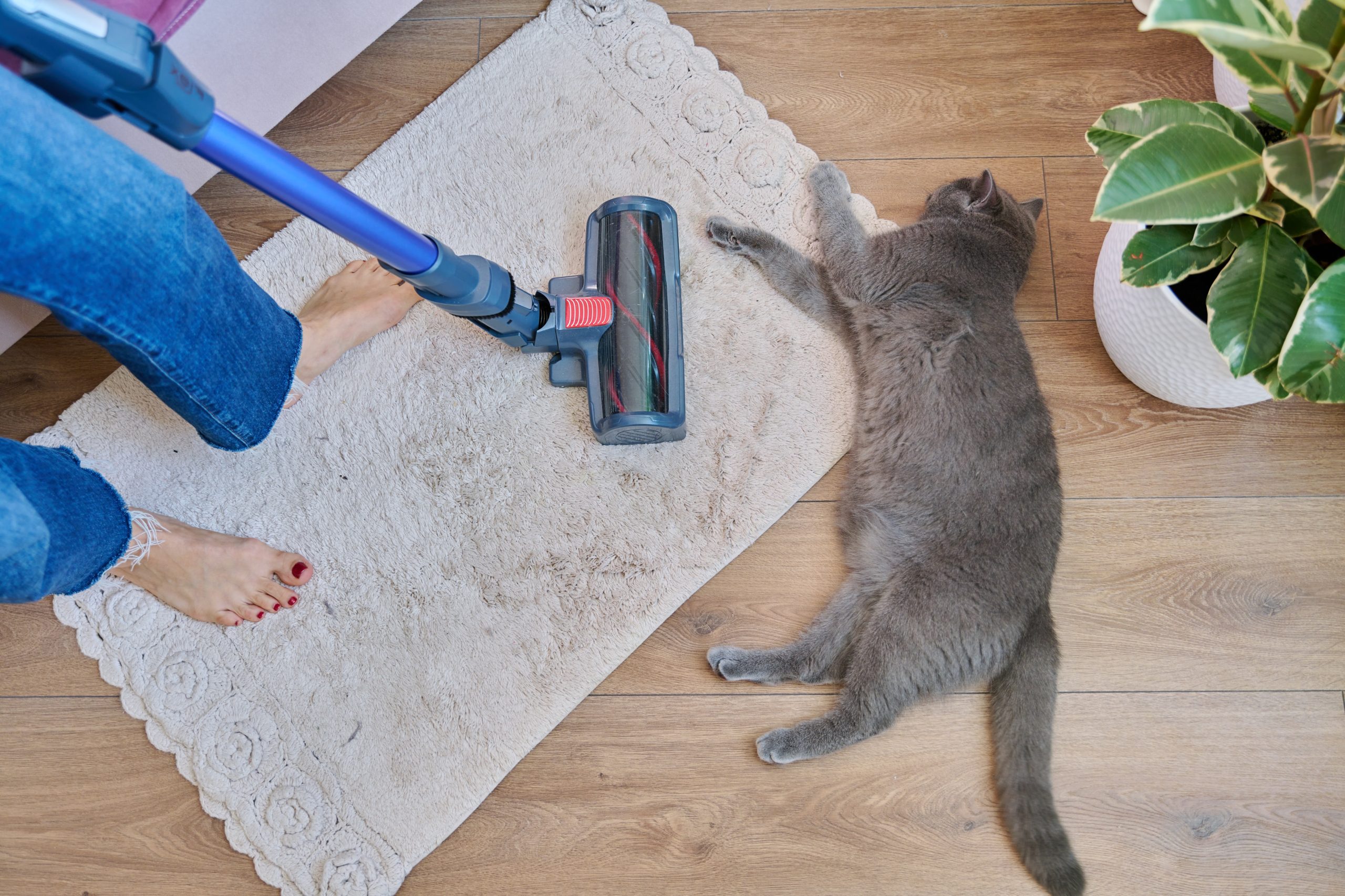
Learning Processes
Cats are always learning, even when they appear inactive. Simply being exposed to an environment in which stimuli are present will result in learning.
How cats experience their environment, including how they perceive their surroundings, results in emotional responses that lead to behavioral changes. These observable behavioral changes are associated with anatomical and physiological changes, primarily in the brain. These behavioral and organic processes constitute learning.
Non-associative Learning
Learning that does not require an association between events or stimuli is called non-associative learning.

Image credit: Valerii Honcharuk/stock.adobe.com
- Cats exposed to a perceived safe and irrelevant stimulus will get used to (or habituated to) it and ignore it; if something is perceived as threatening and potentially dangerous, they will become more fearful-anxious (or sensitized) around it.
- It is a very important form of learning, especially in very young cats, because it determines what stimuli a cat will react to (or ignore) in their environment.
- For example, a cat exposed to loud household noises—such as a vacuum—early in life may be less likely to develop intense fear-anxiety of them later on.
Associative Learning
Classical Conditioning
Cats learn from the association of specific events or stimuli. In classical conditioning, these events or stimuli occur naturally and do not require voluntary action from the cat.
- Occurs when cats form an association between specific stimuli.
- A cat will spontaneously have a negative or protective emotional response to painful stimuli.
- Example: If a specific painful stimulus, such as being pinched by a needle, is always preceded by the sight of the needle itself, the simple sight of the needle will soon trigger the same protective response that the pinch used to trigger. If the veterinarian is part of the picture, a cat may also develop a protective emotional response to their sight. This learning process is called associative learning via classical conditioning
Operant Conditioning
This type of learning is mainly associated with training. In this learning process, cats associate their voluntary actions with the consequences.
- If a cat obtains their desired consequence, the behavior frequency increases (Reinforcement).
- Positive Reinforcement: Adding something pleasant for the cat (e.g., giving a treat when a cat sits for us). The cat will be more likely to sit in the future due to positive reinforcement. Positive reinforcement training should always be used in training.
Engaging (Positive) Emotions
- Engaging emotions like desire-seeking lead to:
- Predatory behavior
- Seeking high-value foods (e.g., treats)
- Seeking pleasure, comfort, +/- social interactions
- Reward-based or positive reinforcement training
- It also leads to optimism associated with increased activity of brain regions in the reward-seeking system
- The activation of engaging emotions is highly motivating for cats, in contrast to protective (negative) emotions.
- Cats trained with methods that elicit engaging emotions have improved welfare and demonstrate more willingness to engage and cooperate, including in veterinary procedures.
- Eliciting engaging emotions through positive reinforcement training usually leads to better outcomes behaviorally and physically than cats who are frequently exposed to aversive stimuli.
Protective (Negative) Emotions
- Fear-anxiety, pain, and frustration are protective emotions that a cat can experience when facing an aversive stimulus, triggering behavioral responses.
- In natural conditions, a cat experiencing these emotions would inhibit, avoid, or repel the aversive stimulus, resulting in an adaptive and short-lived response.
- Companion cats cannot always avoid or remove aversive stimuli as they have limited control of their environment (please see Setting Up the Environment for Success for more information); their protective emotions can remain activated for a long time and cause chronic distress, which is maladaptive and highly detrimental to their physical, emotional, and cognitive health.
- Fear-anxiety is, in fact, the emotion that allowed ancestral cats to stay away from danger, survive, and evolve. A fearful or anxious cat will learn protective behaviors very quickly but will not be able to focus on complex positive associations acquired via operant conditioning. For this reason, a distressed or fearful-anxious cat will be more resistant to training and may refuse even the most enticing treat.
- Aversive stimuli (commonly, but not always appropriately, called punishment and corrections) should be avoided when handling or training cats.
A Healthy Cat is a Better Learner
There is growing evidence of the influence physical health has on learning.
- Medical Assessment First
- When a cat shows difficulties in learning or demonstrates stress-related behaviors, a thorough medical assessment is essential to investigate whether the cat’s physical health affects their emotional and cognitive health
- Impact of Behavioral Health
- Poor emotional health (e.g., chronic fear-anxiety) or cognitive health (e.g., cognitive dysfunction) can affect learning, training, and collaborative handling
- Changes in behavior may be caused by stressors such as cats being indoor-only, intercat tension, recent change in diet, etc.
Two key mechanisms linking physical health and learning are:
- Sickness
- Illness exerts a depressive effect on the brain; a sick cat is distressed, and a distressed cat is not a good learner
- Immune/Inflammatory Response
- Traditionally associated with physical signs such as fever, these changes also affect emotional and behavioral responses and cognition
- For instance, cats with low-grade chronic inflammation typical of aging may show altered interactions with humans in challenging situations, such as when interacting with the cat at home or in the veterinary practice
The Impact of Pain
- Pain is a psychophysical experience: Pain is both a protective emotion and a physical sensation, involving nociception (the perception of a noxious stimulus).
- Behavioral signs of pain exacerbate fear-anxiety: Pain’s inflammatory component can directly affect how the brain regulates behavior.
- Pain assessment is essential: Assess for pain whenever a cat shows unexpected changes or difficulties in learning. Please refer to the FelineVMA Chronic Pain Educational Toolkit for further information.
Role of the Microbiota and Immune/Inflammatory Response
- An additional layer of complexity is added by the roles that the bacterial microbiota of the gut and skin play in regulating metabolic and immune/inflammatory responses, and thereby influencing a cat’s physical and behavioral health.
- A diverse and balanced microbiome has been associated with better behavioral and physical health in different species.
- Dysbiosis can cause behavioral and cognitive alterations.
- It has been shown that cats with chronic inflammatory gastrointestinal or skin disease show more anxious and etepimeletic (care-soliciting) behaviors.
Key Takeaways
- Continuous Learning: Cats are always learning through non-associative and associative processes.
- Emotional State Matters: Chronic distress, such as fear-anxiety, can overshadow positive reinforcement and hinder learning.
- Physical Health Counts: Chronic pain, inflammation, or illness can diminish a cat’s ability to learn. Veterinary assessment is crucial.
- Positive Training Wins: Reward-based methods encourage better cooperation, enhance wellbeing, and improve learning outcomes.
- Punishment: Punishment-based training is never recommended.
